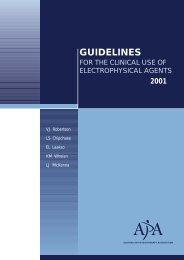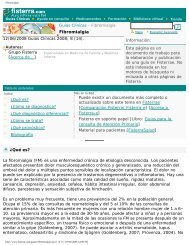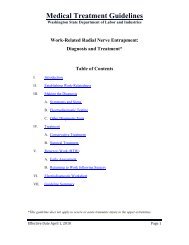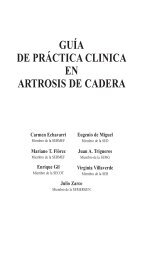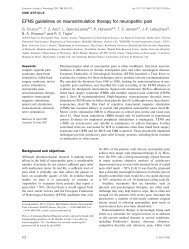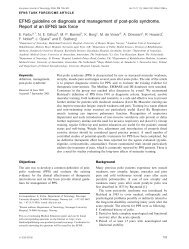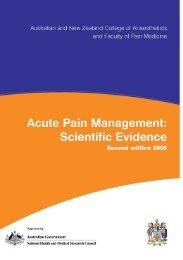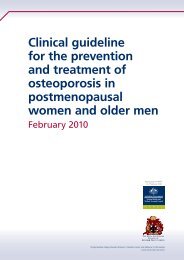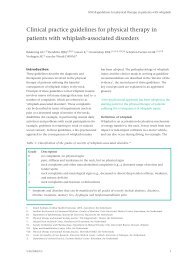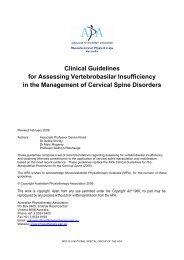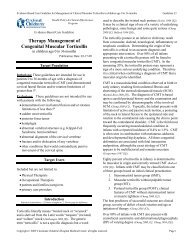<strong>Practice</strong> <strong>Parameter</strong>: Carpal Tunnel Syndromegraded results <strong>of</strong> needle electromyography. Electromyogr ClinNeurophysiol 1994; 34: 377-383. Criteria Met (1/6: 2) Source:Medline Search.177. Nakamichi K, Tachibana S. Restricted motion <strong>of</strong> <strong>the</strong> median nerve incarpal tunnel syndrome. J H<strong>and</strong> Surg 1995;20B:460-464. BackgroundReference. Source: AAEM 2000 CTS Task Force member.Ultrasound imaging <strong>of</strong> <strong>the</strong> mid carpal tunnel permits measurement <strong>of</strong><strong>the</strong> magnitude <strong>of</strong> median nerve sliding with finger flexion. Thestudies demonstrated control subjects median nerves slid 1.75 ± 0.49mm with finger flexion whereas CTS patients median nerves slid 0.37± 0.49 mm. The findings were compatible with limited longitudinalsliding on <strong>the</strong> median nerve in <strong>the</strong> CT <strong>of</strong> CTS patients.178. *Narkas AD. The role <strong>of</strong> thoracic outlet syndrome in <strong>the</strong> double crushsyndrome. Am H<strong>and</strong> Surg 1990;9:331-340. Criteria Met (1/6: 2)Source: Medline Search.179. *Nathan PA, Keniston RC, Meadows KD, Lockwood RS. Predictivevalue <strong>of</strong> nerve conduction measurements at <strong>the</strong> carpal tunnel. MuscleNerve 1993;16:1377-1382. Criteria Met (3/6: 3,5,6) Source: MedlineSearch. Abstract: We compared <strong>the</strong> predictive values <strong>of</strong> threemeasurements <strong>of</strong> sensory conduction <strong>of</strong> <strong>the</strong> median nerve at <strong>the</strong> carpaltunnel (maximum latency difference [MLD], 8 cm latency [S8], <strong>and</strong>14 cm latency [S14]) in 2334 h<strong>and</strong>s <strong>of</strong> industrial workers, workers’compensation patients, <strong>and</strong> students. The MLD for <strong>the</strong> mediansensory nerve across <strong>the</strong> wrist was determined by <strong>the</strong> centimetrictechnique (inching study). The threshold, sensitivity, <strong>and</strong> specificity<strong>of</strong> abnormalities were as follows: MLD ≥ 0.40 ms, 86%, 82%, S8 ≥2.3 ms, 67%, 90% <strong>and</strong> S14 ≥ 3.6 ms, 56%, 94%.180. Nathan PA, Meadows KD, Doyle LS. Relationship <strong>of</strong> age <strong>and</strong> sex tosensory conduction <strong>of</strong> <strong>the</strong> median nerve at <strong>the</strong> carpal tunnel <strong>and</strong>association <strong>of</strong> slowed conduction with symptoms. Muscle Nerve1988;11:1149-1153. Criteria Met (3/6: 1,2,4) Source: Medline Search.181. Nathan PA, Meadows KD, Doyle LS. Sensory segmental latencyvalues <strong>of</strong> <strong>the</strong> median nerve for a population <strong>of</strong> normal individuals.Arch Phys Med Rehabil 1988;69:499-501. Criteria Met (6/6:1,2,3,4,5,6) Source: Medline Search. Abstract: With stimulation at lcm intervals at <strong>the</strong> wrist <strong>and</strong> across <strong>the</strong> carpal tunnel <strong>and</strong> recordingover <strong>the</strong> middle finger, 70 normal h<strong>and</strong>s <strong>and</strong> 54 CTS h<strong>and</strong>s wereevaluated for relative sensitivity <strong>and</strong> specificity at 2 levels <strong>of</strong>abnormality. At 0.5 ms abnormality, <strong>the</strong> specificity was 97% <strong>and</strong>sensitivity was 54%. At 0.4 ms or greater, <strong>the</strong> sensitivity improved to81% <strong>and</strong> specificity dropped to 81%. The positive predictive value at0.5 ms was 93% <strong>and</strong> decreased to 77% at <strong>the</strong> 0.4 ms abnormality.182. Nathan PA, Srinivasan H, Doyle LS, Meadows KD. Location <strong>of</strong>impaired sensory conduction <strong>of</strong> <strong>the</strong> median nerve in carpal tunnelsyndrome. J H<strong>and</strong> Surg Br 1990;15:89-92. Criteria Met (6/6:1,2,3,4,5,6) Source: Medline Search. Abstract: Stimulation in 1 cmsegments across <strong>the</strong> carpal tunnel was performed from 2 cm proximalto <strong>the</strong> distal wrist crease (DWC) to 6 cm distal <strong>and</strong> SNAP latencieswere recorded over <strong>the</strong> middle finger in 70 normal <strong>and</strong> 217 CTSh<strong>and</strong>s. The focal areas <strong>of</strong> slowing were reported with <strong>the</strong> mostcommon area <strong>of</strong> slowing 3 to 4 cm distal to <strong>the</strong> DWC with slowingproximal to <strong>the</strong> DWC being unusual.183. *Nau HE, Lange B, Lange S. Prediction <strong>of</strong> outcome <strong>of</strong>decompression for carpal tunnel syndrome. J H<strong>and</strong> Surg Br1988;13:391-394. Criteria Met (1/6: 3) Source: Medline Search.184. Nesathurai S, Gwardjan A, Kamath AN. Median-to-ulnar sensorynerve action potential amplitude ratio as an electrodiagnostic adjunctfor carpal tunnel syndrome. Arch Phys Med Rehabil 1999;80:756-759. Criteria Met (normal population study 3/6: 3,4,6). Source:Medline Search. Abstract: Retrospective review <strong>of</strong> previouslyobtained NCS data in 46 normal controls to obtain normative data for<strong>the</strong> median-to-ulnar sensory nerve action potential (SNAP) amplituderatio (MUSAR) <strong>and</strong> to discuss <strong>the</strong> potential use <strong>of</strong> MUSAR indiagnosis <strong>of</strong> CTS. Antidromic median <strong>and</strong> ulnar SNAPs wererecorded <strong>and</strong> <strong>the</strong> respective MUSAR ratios were calculated.Descriptive statistical analysis was completed with <strong>the</strong> assumptionthat SNAP values are not Gaussian in distribution. The normalMUSAR ranged from .74 (5th percentile) to 2.5 (95th percentile). TheMUSAR, being an intrapersonal ratio, may decrease <strong>the</strong> falsepositives <strong>and</strong> false negatives that would o<strong>the</strong>rwise arise when usingabsolute values <strong>of</strong> SNAP amplitudes. Fur<strong>the</strong>r studies are needed todetermine <strong>the</strong> clinical <strong>and</strong> application <strong>of</strong> <strong>the</strong> MUSAR value to <strong>the</strong>diagnosis <strong>of</strong> CTS.185. Nielsen VK. Sensory <strong>and</strong> motor nerve conduction in <strong>the</strong> median nervein normal subjects. Acta Med Sc<strong>and</strong> 1973;194:435-443. Criteria Met(normal population study 5/6: 1,3,4,5,6) Source: Buchthal, 1974.Abstract: Orthodromic SNAPs were recorded over <strong>the</strong> median nerveusing needle electrodes at <strong>the</strong> wrist <strong>and</strong> elbow after stimulation <strong>of</strong> <strong>the</strong>thumb <strong>and</strong> middle fingers. CMAPs were recorded with concentricneedle electrodes placed in <strong>the</strong> endplate zone <strong>of</strong> <strong>the</strong> APB afterstimulation at <strong>the</strong> wrist <strong>and</strong> elbow. NCVs were determined for 28male <strong>and</strong> 20 female normal subjects aged 16 to 62 years. There wasno significant difference in NCV between male <strong>and</strong> female subjects.There was a decrease in NCV with increasing age. No CTS patientswere studied.186. Occupational Disease Surveillance. Carpal tunnel syndrome. MMWRMorb Mortal Wkly Rep 1989;38:485-489. Background ReferenceSource: Baker, 1990.187. *Osborn JB, Newell KJ, Rudney JD, Stoltenberg JL. Carpal tunnelsyndrome among Minnesota dental hygienists. J Dent Hyg1990;64(2):79-85. Criteria Met (2/6: 1,2) Source: Medline Search.188. Padua L, Lo Monaco M, Valente EM, Tonali PA. A usefulelectrophysiologic parameter for diagnosis <strong>of</strong> carpal tunnel syndrome.Muscle Nerve 1996;19:48-53. Criteria Met (6/6: 1,2,3,4,5,6). Source:Medline Search. Abstract: In 43 patients (50 h<strong>and</strong>s) with clinicalmanifestations <strong>of</strong> mild-moderate CTS <strong>and</strong> 36 healthy volunteers (40h<strong>and</strong>s), orthodromic sensory nerve conduction velocity (SNCV) wasmeasured with surface electrodes in <strong>the</strong> median nerve between <strong>the</strong>third digit <strong>and</strong> palm <strong>and</strong> between <strong>the</strong> palm <strong>and</strong> wrist. These figureswere used to calculate <strong>the</strong> ratio <strong>of</strong> distal to proximal conduction(distoproximal ratio). All 90 h<strong>and</strong>s were also subjected to o<strong>the</strong>r nerveconduction studies used for diagnosis <strong>of</strong> CTS. All control h<strong>and</strong>spresented distoproximal ratios less than 1.0 reflecting higherconduction rates in <strong>the</strong> proximal segment. In contrast, 49 <strong>of</strong> 50 CTSh<strong>and</strong>s (98%) presented reversed ratios (>1.0) indicating compromisedproximal conduction. The sensitivity <strong>of</strong> this test was significantlygreater than that <strong>of</strong> o<strong>the</strong>r methods evaluated, including comparativestudies <strong>and</strong> segmental study <strong>of</strong> <strong>the</strong> palm-wrist portion <strong>of</strong> <strong>the</strong> mediannerve. Segmental study <strong>of</strong> median SNCV with calculation <strong>of</strong> <strong>the</strong>distoproximal ratio is a sensitive technique for diagnosis <strong>of</strong> CTS inpatients with normal findings in st<strong>and</strong>ard nerve conduction studies.Note: The author indicated by correspondence that <strong>the</strong> mean ± SD for<strong>the</strong> Control DML in Table 1 should read 3.2 ± 0.4 <strong>and</strong> not 3.2 ± 0.8 aspublished.189. Padua L, LoMonaco M, Gregori B, Valente EM, Padua R, Tonali P.Neurophysiological classification <strong>and</strong> sensitivity in 500 carpal tunnelsyndrome h<strong>and</strong>s. Acta Neurol Sc<strong>and</strong> 1997;96:211-217. Criteria Med(6/6: 1,2,3,4,5,6) Source: Medline Search. Abstract: Prospective study<strong>of</strong> 500 h<strong>and</strong>s (379 patients) with clinical diagnosis <strong>of</strong> CTS symptoms.Normal values from <strong>the</strong> same laboratory previously published (Padua,1996). In <strong>the</strong> 500 CTS patients, DML was prolonged (55%), medianorthodromic sensory latency was prolonged (D2, 74%; D3, 67%). Of<strong>the</strong> remaining 117 patients with normal DML <strong>and</strong> medianorthodromic sensory studies over 14 cm, <strong>the</strong> median sensory palmwristNCV over 8 cm was abnormal in 21% <strong>and</strong> <strong>the</strong> distoproximoratio <strong>of</strong> <strong>the</strong> median palm <strong>and</strong> digit segments was abnormal in 87%.190. Palliyath SK, Holden L. Refractory studies in early detection <strong>of</strong> carpaltunnel syndrome. Electromyogr Clin Neurophysiol 1990;30:307-309.Criteria Met (5/6: 1,3,4,5,6) Source: Medline Search. Abstract: Usingpaired stimuli <strong>and</strong> varying <strong>the</strong> inter-stimulus interval, <strong>the</strong> absoluterefractory period (ARP) <strong>and</strong> relative refractory period (RRP), weredetermined in 10 patients with mild electrophysiologic changessuggestive <strong>of</strong> CTS. They found that <strong>the</strong> sensory RRP was sensitive indiagnosing early CTS.191. *Pavesi G, Olivieri MF, Misk A, Mancia D. Clinicalelectrophysiologicalcorrelations in <strong>the</strong> carpal tunnel syndrome. Ital JNeurol Sci 1986;7:93-96. Criteria Met (3/6: 2,3,5) Source: MedlineSearch.192. Pease WS, Cannell CD, Johnson EW. Median to radial latencydifference test in mild carpal tunnel syndrome. Muscle Nerve1989;12:905-909. Criteria Met (4/6: 1,3,5,6) Source: Medline Search.Abstract: The following techniques were studied: (a) antidromic DSLmedian radial differences to <strong>the</strong> thumb, (b) antidromic DSL afterstimulation at <strong>the</strong> wrist <strong>and</strong> recording from <strong>the</strong> third digit, (c) medianmid-palmar DSL compared as a ratio <strong>of</strong> <strong>the</strong> wrist to middle fingerDSL, (d) median ulnar DSL latency difference between <strong>the</strong> ulnarS970 CTS <strong>Literature</strong> <strong>Review</strong>© 2002 American Association <strong>of</strong> Electrodiagnostic Medicine
<strong>Practice</strong> <strong>Parameter</strong>: Carpal Tunnel SyndromeSNAP recorded from <strong>the</strong> little finger after stimulation at <strong>the</strong> wrist <strong>and</strong><strong>the</strong> median DSL after stimulation at <strong>the</strong> wrist <strong>and</strong> recording from <strong>the</strong>middle finger, <strong>and</strong> (e) median motor DML after recording from <strong>the</strong>APB after stimulation at <strong>the</strong> wrist. Three hundred thirty-threesymptomatic h<strong>and</strong>s in 262 patients were initially evaluated withsubgroups <strong>of</strong> patients with CTS evaluated with different tests. Themedian radial DSL difference <strong>and</strong> median ulnar DSL difference weremost likely to be abnormal followed by median DSL <strong>the</strong>n <strong>the</strong> palmto-wristDSL latency ratio <strong>and</strong> lastly <strong>the</strong> DML.193. Pease WS, Cunningham ML, Walsh WE, Johnson EW. Determiningneurapraxia in carpal tunnel syndrome. Am J Phys Med Rehabil1988;67:117-119. Criteria Met (5/6: 1,3,4,5,6) Source: MedlineSearch. Abstract: With needle stimulation at <strong>the</strong> wrist <strong>and</strong> midpalm,CMAPs were recorded over <strong>the</strong> APB in 25 CTS patients <strong>and</strong> 23healthy asymptomatic persons. They found a significant difference in<strong>the</strong> amplitude <strong>of</strong> <strong>the</strong> CMAP in <strong>the</strong> CTS group when compared to <strong>the</strong>control group. They propose that this is evidence for conduction block(neurapraxia) in CTS.194. Pease WS, Lee HH, Johnson EW. Forearm median nerve conductionvelocity in carpal tunnel syndrome. Electromyogr Clin Neurophysiol1990;30:299-302. Criteria Met (4/6: 1,3,4,5) Source: Medline Search.Abstract: The NCV <strong>of</strong> <strong>the</strong> median nerve in <strong>the</strong> forearm wasdetermined by 2 methods: (a) stimulation in <strong>the</strong> forearm <strong>and</strong>recording <strong>the</strong> nerve action potential at <strong>the</strong> wrist, <strong>and</strong> (b) stimulation at<strong>the</strong> wrist <strong>and</strong> elbow with recording over <strong>the</strong> APB, in 21 CTS patients<strong>and</strong> 16 control subjects. They found that <strong>the</strong> forearm NCV wasslowed in <strong>the</strong> CTS group using ei<strong>the</strong>r technique. The authors haveproposed that this suggest that <strong>the</strong>re is proximal nerve dysfunction asa result <strong>of</strong> median nerve compression in <strong>the</strong> carpal tunnel.195. *Peterson GW, Will AD. Newer electrodiagnostic techniques inperipheral nerve injuries. Orthop Clin North Am 1988;19:13-25.Criteria Met (0/6) Source: Narkis, 1990.196. *Phalen GS. The carpal tunnel syndrome: clinical evaluation <strong>of</strong> 598h<strong>and</strong>s. Clin Orthop 1972;83:29-40. Background Reference. Source:Katz 1990 (J Rheumatology).197. *Phalen GS. The carpal tunnel syndrome: seventeen years’experience in diagnosis <strong>and</strong> treatment <strong>of</strong> 654 h<strong>and</strong>s. J Bone Joint Surg1966;48:211-228. Criteria Met (1/6: 2) Source: Meyers, 1989.198. Phalen GS, Gardner WJ, LaLonde AA. Neuropathy <strong>of</strong> <strong>the</strong> mediannerve due to compression beneath <strong>the</strong> transverse carpal ligament. JBone Joint Surg 1950;32-A:109-112. Background Reference. Source:Braun, 1989.199. Plaja J. Comparative value <strong>of</strong> different electrodiagnostic methods incarpal tunnel syndrome. Scan J Rehabil Med 1971;3:101-108. CriteriaMet (4/6: 1,3,5,6) Source: Joynt, 1989. Abstract: The followingtechniques were studied: (a) CMAP potentials were recorded afterstimulation at <strong>the</strong> wrist <strong>and</strong> recording with coaxial needle electrodes,(b) orthodromic SNAPs with stimulation over <strong>the</strong> index finger <strong>and</strong>recording with surface electrodes at <strong>the</strong> wrist, (c) needle EMG using acoaxial needle, (d) strength/duration curves <strong>and</strong> chronaxy. Fifty-sixcases <strong>of</strong> CTS <strong>and</strong> 20 normal subjects were evaluated. Sensorylatencies were more likely to be abnormal than <strong>the</strong> o<strong>the</strong>r techniquesmeasured.200. Preston DC, Logigian EL. Lumbrical <strong>and</strong> interossei recording incarpal tunnel syndrome [see comments]. Muscle Nerve 1992; 15:1253-1257. Criteria Met (5/6: 1,3,4,5,6) Source: Medline Search.Abstract: Median motor studies are commonly “normal” in mildcarpal tunnel syndrome (CTS). This reflects ei<strong>the</strong>r <strong>the</strong> sparing <strong>of</strong>motor compared to sensory fibers, or <strong>the</strong> inability <strong>of</strong> conventionalstudies to detect an abnormality. A novel approach to demonstrateearly motor fiber involvement in CTS is <strong>the</strong> placement <strong>of</strong> <strong>the</strong> sameactive electrode lateral to <strong>the</strong> third metacarpal, allowing recordingfrom <strong>the</strong> second lumbrical or <strong>the</strong> deeper interossei, when stimulating<strong>the</strong> median or ulnar nerves at <strong>the</strong> wrist, respectively. We compared<strong>the</strong> difference between <strong>the</strong>se latencies in 51 normal control h<strong>and</strong>s to107 consecutive patient h<strong>and</strong>s referred with symptoms <strong>and</strong> signssuggestive <strong>of</strong> CTS, who were subsequently proven to haveelectrophysiologic CTS by st<strong>and</strong>ard nerve conduction criteria. Aprolonged lumbrical-interossei latency difference (>0.4 ms) wasfound to be a sensitive indicator <strong>of</strong> CTS in all patient groups. It wasalso helpful in patients with coexistent polyneuropathy, wherelocalization <strong>of</strong> median nerve pathology at <strong>the</strong> wrist was o<strong>the</strong>rwisedifficult.201. *Preston DC, Ross MH, Kothari MJ, Plotkin GM, Venkatesh S,Logigian EL. The median-ulnar latency difference studies arecomparable in mild carpal tunnel syndrome. Muscle Nerve 1994; 17:1469-1471. Criteria Met (2/6: 1,3). Source: Medline Search. Abstract:Compares sensitivity 159 patients <strong>of</strong> orthodromic palm-wrist mixedpalmar median-ulnar peak latency difference with normal



